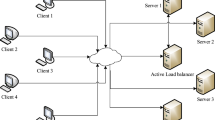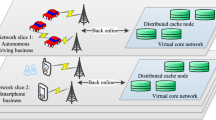Abstract
In today’s society, the development of the new ecology of smart education has brought new opportunities and challenges to our country's future education, which all benefit from the rapid development of 5G technology industry. As we all know, multi trip scheduling optimization model is always the focus of distributed computing platform. The goal of distributed platform multi trip scheduling is to find a reasonable task scheduling strategy to minimize the task completion time, which includes transmission time, calculation time and result return time. Most of the existing studies assume that the return time of the results can be ignored, but in fact, the transmission time of the conclusions can not be ignored. Therefore, an updated scheduling model is very important. This paper discusses a new model, namely multi trip scheduling optimization model, which needs algorithm to calculate reasonable values. In view of this, this paper studies the multi trip scheduling optimization model with result collection under two communication modes, and designs an efficient algorithm to solve the model.







Similar content being viewed by others
References
Beckel C, Sadamori L, Staake T, Santini S (2014) Revealing household characteristics from smart meter data. Energy 78:397–410. https://doi.org/10.1016/j.energy.2014.10.025
Cao W, Wu S, Yu Z, Wong HS (2018) Exploring correlations among tasks, clusters, and features for multitask clustering. IEEE Trans Neural Netw Learn Syst 30(2):355–368
Covington P, Adams J, Sargin E (2016) Deep neural networks for youtube recommendations. In: Proceedings of the 10th ACM conference on recommender systems, Boston, Massachusetts, USA, September 15–19, 2016, pp 191–198
Dong YF, Kanhere S, Chou CT, Bulusu N (2008) Automatic collection of fuel prices from a network of mobile cameras. In: Nikoletseas SE, Chlebus BS, Johnson DB, Krishnamachari B (eds) Distributed computing in sensor systems. DCOSS 2008. Lecture notes in computer science, vol 5067. Springer, Berlin, pp 140–156
Du WS (2019) Correlation and correlation coefficient of generalized orthopair fuzzy sets. Int J Intell Syst 34(4):564–583
Francis G, Oliver J, Mulpuri S (2018) High yielding and trait specific genotypes and genetic associations among yield and yield contributing traits in Jatropha curcas L. Agrofor Syst 92(5):1417–1436
Gaston N (2018) Cluster melting: new, limiting, and liminal phenomena. Adv Phys X 3(1):1401487
Gaur M, Majumdar A (2018) Disaggregating transform learning for non-intrusive load monitoring. IEEE Access 6:46256–46265. https://doi.org/10.1109/ACCESS.2018.2850707
Hart GW (1992) Nonintrusive appliance load monitoring. Proc IEEE 80:1870–1891. https://doi.org/10.1109/5.192069
Hosseini B, Kiani K (2018) FWCMR: a scalable and robust fuzzy weighted clustering based on MapReduce with application to microarray gene expression. Expert Syst Appl 91:198–210
Kelly J, Knottenbelt W (2015) Neural NILM: deep neural networks applied to energy disaggregation. In: BuildSys 2015—Proceedings of the 2nd ACM international conference on embedded systems for energy-efficient built, pp 55–64
Krivic P, Skocir P, Kusek M, Jezic G (2018) Microservices as agents in IoT Systems. In: Jezic G, Kusek M, Chen-Burger YH, Howlett R, Jain L (eds) Agent and multi-agent systems: technology and applications. KES-AMSTA 2017. Smart innovation, systems and technologies, vol 74. Springer, Cham, pp 22–31
Liu G, Guo W, Li R, Niu Y, Chen G (2015) XGRouter: high-quality global router in X-architecture with p swarm optimization. Front Comput Sci 9(4):576–594
Motwani M, Tiwari A (2014) A novel semi supervised algorithm for text classification using BPNN by active search. IJCSI Int J Comput Sci Issues 11(3):154–160
Parson O, Ghosh S, Weal M, Rogers A (2014) An unsupervised training method for non-intrusive appliance load monitoring. Artif Intell 217:1–19. https://doi.org/10.1016/j.artint.2014.07.010
Roy SS, Samui P, Nagtode I et al (2020) Forecasting heating and cooling loads of buildings: a comparative performance analysis. J Ambient Intell Humaniz Comput 11:1253–1264. https://doi.org/10.1007/s12652-019-01317-y
Shuai C, Yang H, Ouyang X, He M, Gong Z, Shu W (2018) Analysis and identification of power blackout-sensitive users by using big data in the energy system. IEEE Access 7:19488–19501
Tabatabaei SM, Dick S, Xu W (2017) Toward non-intrusive load monitoring via multi-label classification. IEEE Trans Smart Grid 8:26–40. https://doi.org/10.1109/TSG.2016.2584581
Wang Z, Zheng G (2012) Residential appliances identification and monitoring by a nonintrusive method. IEEE Trans Smart Grid 3:80–92. https://doi.org/10.1109/TSG.2011.2163950
Zeinal-Kheiri S, Shotorbani AM, Mohammadi-Ivatloo B (2020) Residential load disaggregation considering state transitions. IEEE Trans Ind Inf 16:743–753. https://doi.org/10.1109/TII.2019.2925323
Author information
Authors and Affiliations
Corresponding author
Additional information
Publisher's Note
Springer Nature remains neutral with regard to jurisdictional claims in published maps and institutional affiliations.
Rights and permissions
About this article
Cite this article
Liu, C., Wang, L. & Liu, H. 5G network education system based on multi-trip scheduling optimization model and artificial intelligence. J Ambient Intell Human Comput (2021). https://doi.org/10.1007/s12652-021-03205-w
Received:
Accepted:
Published:
DOI: https://doi.org/10.1007/s12652-021-03205-w




